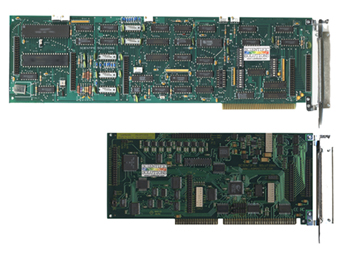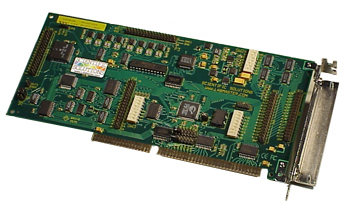
Scientific Solutions ® Inc.
LabTender ® Data Acquisition Product
| Product Description |
Four key data acquisition and control functions (on one PC board) are included in a high performance, cost effective package. New Version provides 16-bit data, Enhanced Digital I/O Drive Capabilities, and ESD/Over-Voltage Protection!....While keeping 100% Compatible with the original!
The LabTender was first introduced in 1981. It has been available and supported continuously ever since, and is used in many diverse applications including laboratory testing, entertainment/training flight simulators, and factory automation. The newest version of the LabTender expands the original features - increasing the D/A and A/D data from 8 bit to 16 bit, increasing the sink/source current of the Digital I/O, and reducing the physical size to fit in slim computers. Great care is taken in the design and manufacturing of the LabTender to insure a quality product that provides accuracy and stability for demanding applications. Its feature-full rugged design and reliability make it ideal for acquiring and analyzing data in industrial, scientific, and educational fields. |
 Product Description
Product Description
Turn your PC into an educational, industrial, or scientific workstation. Four key data acquisition & control functions are included in a high performance, very cost competitive package. 32 single-ended or 16 differential input channels are multiplexed to one Analog-to-Digital Converter (ADC). One Digital-to-Analog Converter (DAC) is multiplexed to 16 individual sample and hold outputs. Five 16-bit precision timer/counters provide interval timing to 1 microsecond resolution and event counting to 160 nsec. accuracy. 24 lines of TTL compatible digital I/O complete this multipurpose data acquisition and control product. Our optional LabPac for DOS or LabPac32 for Windows software provides a flexible, multi-purpose interface for customized programs using any language.
 Our Solution Includes
Our Solution Includes
- Low-cost, multi-purpose Data Acquisition & Control hardware for ISA based PCs
- LabTender User Guide
- Optional LabPac Software:
- LabPac for DOS - Flexible universal driver for all DOS languages
- LabPac32 for Windows - Kernel Mode 32-bit Device Driver and LabPac32 Dynamic Link Library
 Key Features
Key Features
- 32 single-ended/ 16 differential ADC input channels
- ADC data available as both 16-bit or 8-bit
- ADC sampling to 50,000/second
- Accurate timed A/D using pacer clock
- 16 DAC output channels
- DAC data can be either 16-bit or 8-bit
- 24 lines of programmable Digital I/O with Dynamic Direction Buffering and ESD/Over-Voltage Protection
- Five high speed, 16-bit timer/counters (optional on some versions)
- Hardware Interrupts for Multiple Sources
- 100% Compatible with original 8-bit version first introduced in 1981 (protecting your development investment)
 Applications
Applications
- Energy Management (boiler valve control, timing, alarm management)
- Biomedical (physical stress, physiological simulation)
- Psychology (Polygraph, interval timing, switch detection, stimulus control)
- Process Automation (cement prod., production line monitoring, unit counting)
- Test and Measurement (ATE, weight, continuity testing)
- Closed loop control (vehicle dynamics - pitch/roll/heave)
 Functional Description
Functional Description
The four Lab Tender functions situated on 3/4 length PC board, interface to external equipment through ribbon cables that attach to five 34-pin header connectors. A restraining clamp holds the cables in place. Software communicates via sixteen I/O locations (using the IN/OUT instructions).
 Analog-to-Digital Conversion (ADC)
Analog-to-Digital Conversion (ADC)
Low level analog signals are converted to digital information by a successive approximation converter. It has a 20 microsecond conversion cycle. One of 32 single-ended or 16 differential inputs is multiplexed to the analog to digital (ADC) converter. The ADC is configured for ±5V operation. An A/D conversion (enabled by software) is triggered by a software command, a pacer clock, or a rising edge from an external source. The end of a conversion can be detected using a hardware interrupt or by polling a status register. Sampled data is transferred by reading from the card. The data can either be read as 8 bit (compatible with previous version) or read as 16 bit data (new capability).
 Digital-to-Analog Conversion (DAC)
Digital-to-Analog Conversion (DAC)
One Digital-to-Analog Converter (DAC) is multiplexed to 16 sample/hold outputs. The voltage output (±5V @ +5mA) from each S/H is changed by selecting the channel followed by the value for the DAC. The sample/hold outputs are not latched. To maintain a constant output voltage without decay, each output should be refreshed - this is automatically handled by our LabPac32 device driver! The data can either be as 8 bit (compatible with previous version) or as 16 bit data (new capability).
 System Timer/Counter (STC)
System Timer/Counter (STC)
Five independent 16-bit timer/counters count TTL compatible pulses (rising or falling edge) generated from a wide range of equipment and sensors. Each gateable counter can count up or down while accumulated counts may be read without disturbing the counting process. Each of the counters can be connected to others to form a counter with resolution up to 80 bits. The counters can be driven by an onboard 1 MHz crystal giving them a resolution to 1µsec. External events can be counted at speeds to 6.25 MHz. A TTL compatible output is available for each counter. Programming all counters is through one command/status location and a data location.
 Digital Input/Output (DIO)
Digital Input/Output (DIO)
The 24 lines of TTL compatible I/O are addressable in two groups of eight and two groups of four (24 input, 24 output, 8-I / 16-O, 16-I / 8-O, or 12-I / 12-O). All outputs are latched. Simple input is unlatched while strobed input is latched. The digital I/O is programmed through four locations. One location is a command register to configure the 24 lines. The three data locations are contiguous in the I/O space.
The LabTender fully supports the following Digital I/O modes:
- Mode 0 - Basic Digital Input and Output
- Mode 1 - Fully handshaked strobed Digital Input and Output
- Mode 2 - Fully handshaked strobed Bi-Directional Digital Input and Output
- 16 bit Offset Binary
- 150uV / bit
- Auto-converted to Two's Complement by LabPac32
- 16 bit Offset Binary
- 150uV / bit
- Auto-converted from Two's Complement by LabPac32
- Mode0 - Basic I/O
- Mode1 - Strobed I/O
- Mode2 - Srobed Bi-Directional
The LabTender is equipped with Dynamic Digital Buffering (DDB). This provides automatic digital buffering for ALL of the Digital I/O modes - mode0, mode1 and mode2. The DDB provides for 15ma of sink/source current while also providing advanced ESD and Over-voltage protection with fast 6nSec switching.
 Interrupts
Interrupts
Hardware interrupts allow the computer's processor to react to special events when they occur. The Lab Tender provides four software enabled sources for hardware interrupts (timer/counter outputs, end of A/D conversion, A/D data overrun, and the handshake strobes for digital I/O) or other external sources. Hardware interrupts require software to process the request.
 System Resources
System Resources
The LabTender occupies a single ISA slot and is a short board for today's smaller computer cases. The connection from the computer to the outside world is thru five 37-pin header connectors (one for Timer, one for Digital I/O, one for Analog Out and two for Analog In.) The board has a special designed bracket that permits all the cables to exit from the single board slot, while also providing strain relief.
The LabTender occupies 16 locations in the I/O space of the computer. The address of each card in your computer must be unique. The default base address of 0330h can be easily changed if there is an address conflict or you are installing multiple LabTender cards in your system.
Besides the Base Address I/O space, the LabTender can also use Interrupt resources of your computer. These resources are jumper selected and software enabled by your application software or the LabTender device driver.
The LabTender provides 100% compatibility with the original version. It adds features, but is a much smaller size for today's slim case computers. The following picture compares the size of the original to the new LabTender.

 Technical Specifications
Technical Specifications
| Resolution | 16-bit data word with 12-bit hardware resolution |
|---|---|
| Input Range | ± 5V |
| LSB | 2.44mV |
| Conversion Time | 20µSec. |
| Maximum Sampling rate | 50,000 samples/second |
| Channel Count | 32 |
| Input Bias Current | 100pAmps |
| Source Impedance | < 10Kohms |
| S/(N+D) | 72dB typical |
| THD | -80dB typical |
| Low Drift Voltage Reference | 25 ppm/ºC |
| Integral Linearity | ±1 LSB |
| Full Scale Error | 1 LSB (typical) |
| Offset Error | 1 LSB (typical) |
| Performance | No missing codes |
| Input Protection | ±5 volts |
| Data Format |
|
| Data Transfer | Programmed I/O |
| Resolution | 16-bit data word with 12-bit hardware resolution |
|---|---|
| Output Range | ± 5V |
| LSB | 2.44mV |
| Maximum Update rate | 50,000 samples/second |
| Channel Count | 16 |
| Differential Non-Linearity | 1 LSB max |
| Integral Non-Linearity | 1 LSB max |
| Output Current | 5ma |
| Data Format |
|
| Data Transfer | Programmed I/O |
| Resolution | 16-bit / counter |
|---|---|
| Number of Counters | 5 Independent |
| Maximum Counter Resolution | 80bit by cascading |
| Logic Thresholds | TTL |
| Interval Counting Resolution | 1 µSec. |
| Event Counting | 6.25Mhz (160nSec. intervals) |
| Data Transfer | Programmed I/O |
| Number of bits | 24 bits of Digital I/O |
|---|---|
| Programmable Modes |
|
| Data Transfer | Programmed I/O |
| Logic Thresholds | TTL |
| Current Sink/Source | 15 ma |
| Input/Output Protection | ESD Overvoltage, 6nSec. switching |
| Bus Interface | Single ISA slot |
|---|---|
| IRQ Channels (hardware selectable) | 2,3,4,5,6,7 |
| I/O Address (switch selected) | Any address, uses 16 locations |
| Default I/O Address | 0330h - 033Fh |
| Bus Load | 1 TTL load/bus line |
| Board Size | 8.75" (223mm) |
| Operating Temperature | 0º to 70º Celsius |
|---|---|
| Storage Temperature | -25º to +85º Celsius |
| Relative Humidity | To 95% non-condensing |
| Agency Approvals | FCC Class A, CE-Mark |
 Frequently Asked Questions
Frequently Asked Questions
Q1. The LabTender has been available since 1981. Will the new version of the LabTender replace an original version? Do I have to change my software or cabling?
A1. The current LabTender is 100% compatible with the original so it will run all programs written for the LabTender - even those created in 1981! You do not have to change any of your software or cabling...it is a direct plug-in replacement. It's smaller size makes it easier to install in the newer slim PC cases.
Q2. How can the new LabTender be compatible with the original, when the new version has higher resolution A/D and D/A capabilities?
A2: The older LabTender only provided 8 bit A/D and D/A data. The new LabTender has the same 8 bit data available (to maintain compatibility), but also adds some additional new registers that provide 16 bit A/D and D/A data. Software can read the 8 bit registers to obtain the 8 bit data or read the newer 16 bit registers to obtain the 16 bit data.
Q3. Scientific Solutions offers versions of the new LabTender with or without the on-board timer. (Note: All older versions - full size card - have the Counter/Timer. The option is only with the newer version). How do I know if my application is using this timer?
A3: Take a look at how the board is configured and what connections you are using. If you use either connector P5 or the timer interrupt then your application is using the on-board Counter/Timer and you need to make sure the LabTender you get has this feature.
Connector P5 is the 37-pin header connector on the far left side of the board. If a cable is attached to this connector, then the counter/timer is being used.
U37 is a socket on the older LabTender. It is located just above and to the left of the card's gold fingers. When shipped from the factory, there is a header plugged into this socket. If any interrupts are being used, there will be a wire soldered from the left side to the right side of this header. If there is no wire, then no interrupts are being used. Pin 1 of this header is the top left position, and the header pin out is as follows:
| Function | Pin Number | Pin Number | Function |
|---|---|---|---|
| OE | 1 | 16 | IRQ2 |
| DONE | 2 | 15 | IRQ3 |
| TINT | 3 | 14 | IRQ4 |
| PIO1 | 4 | 13 | IRQ5 |
| PIO2 | 5 | 12 | IRQ6 |
| OE|DONE | 6 | 11 | IRQ7 |
| RESERVED | 7 | 10 | RESERVED |
| RESERVED | 8 | 9 | RESERVED |
If there is a wire from Pin 3 (TINT=Timer Interrupt) on the left side of the header) to any other pin on the right side, then this means the timer is being used to create interrupts in the PC.
In summary, if either(or both) P5 is used, or the Timer Interrupt (TINT) is used, then you need the Counter/Timer feature on your LabTender.
Q4. What operating systems can I use with the LabTender?
A4: Scientific Solutions has drivers for DOS (LabPac for DOS) and for Windows (LabPac for Windows). The DOS driver is implemented as a TSR driver. The Windows driver is a true 32-bit kernel mode driver for Windows 9x, and NT/2000. We are pleased to provide support to customers who want to create their own device driver for other operating systems such as Linux, BSD, etc.
Q5. How do I convert the 16-bit A/D data from the new LabTender into volts?
A5: The conversion of the "raw" data to the actual units you are measuring (volts in this example), depends upon four factors - the resolution of the A/D data (16bits), the range (-5volts to +5volts) of the ADC, the Gain used when the analog signal was converted, and the format of the raw data (Offset Binary for direct hardware reads, Two's Complement if using LabPac32). Here is a quick equation that you can use (assumes Two's Complement data from LabPac32)..however make sure the arithmetic you are using is "signed" to account for two's complement formats:
volts = (count) * (range) / (gain) / (2 raised to the power of "resolution")
Example: data is 3FFFh, range is -5v to +5v, gain=1, resolution of data is 16 bit:
note: 3FFFh = 16383 decimal
volts = (3FFF) * (10) / (1) / (2 rasied to the power of 16)
volts = (16383) * (10) / (1) / (65536)
volts = 2.4998
Specifications subject to change without notice.
Scientific Solutions liability, trademarks, and export notices apply.
Copyright © 1972-2025 Scientific Solutions - All rights reserved.
